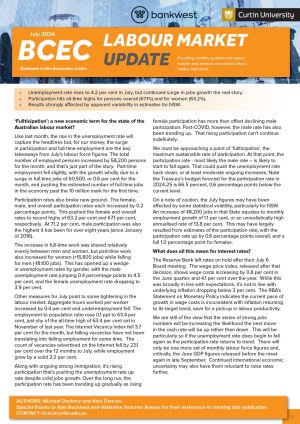BCEC Monthly Labour Market Update – June 2024
— Run of strong employment growth extends into third month. —
— Unemployment rate back up to 4.1 per cent as more women enter the labour force. —
— A 6th of August increase in the official cash rate now firmly on the cards. —
Jobs surge heightens chance of an interest rate rise
Nationally the number of persons in employment increased by 50,200 in the month of June 2024, rounding off a quarter of very robust employment growth. As it happens, the increase in the number of employed persons in June almost exactly matched the ABS’s estimate of the rate at which the working-age population is currently expanding, at 49,600 persons per month.
Don’t be fooled by the increase in the headline unemployment rate from 4.0 per cent to 4.1 per cent. The labour market remains strong, with the unemployment rate edging over 4 per cent only due to near record rates of participation and the ongoing influx of working-age migrants.
The participation rate increased 0.1ppt to 66.9 per cent in June, just shy of the all-time record of 67.0 per cent. The unemployment rate actually increased by just one-half of a percentage point, helped to 4.1 per cent by a good deal of rounding, and the trend estimate remains at 4.0 per cent.
It was already clear from the May labour force figures that the current rate of employment growth is higher than that consistent with Treasury’s scenario for inflation returning to the Reserve Bank of Australia’s (RBA’s) target of 2-3 per cent per annum over 2024-25.
The increase in jobs in June was the largest in four months, and marked the second consecutive month of very strong growth in full-time employment, which is now trending up at an annualised growth rate of over 4 per cent.
For the record, we can now compare the actual June quarter 2024 figures to the projections contained in the recent May federal budget.
Employment growth in the 12 months to the June quarter came in at 2.72 per cent, almost half a percentage point above the projected 2.25 per cent; and the participation rate was 66.8 per cent compared to a projected 66.5 per cent.
The budget projection for the unemployment rate was spot on at 4.0 per cent for the quarter but for the wrong reasons, having assumed fewer jobs and people starting to drop out of the labour force.
The critical June monthly and quarterly consumer price index (CPI) figures will be released at the end of July, a week before the RBA Board meeting on 5-6 August.
The Board pays most attention to the quarterly CPI figure, as it is based on price changes for the full basket of goods and services included in the index.
Given monthly figures for April and May of 3.6 per cent and 4.0 per cent respectively, the June quarterly CPI is very unlikely to be heading in the right direction from the March quarter figure of 3.6 per cent.
The likely increase in the quarterly CPI figure for June would surely test the RBA’s patience, given the absence of any signs of employment growth faltering in the June labour force figures.
A tale of two mining states
The two key mining states of WA and Queensland had the highest rates of employment growth in the 12 months to June, at 5.0 per cent and 4.2 per cent, respectively.
At first blush, that might suggest the mining sector is propping up the national economy. However, more detailed employment figures by state and industry, released at the end of June, tell a different story.
Employment in mining in Queensland increased by 9.5 per cent over the year to May 2024. In contrast, jobs in WA’s mining sector had fallen by 17.6 percent. Nationally the sector has shed 35,300 jobs (-10.9%) since May last year, with 31,000 of those jobs lost in WA.
Ominously, since those figures were collated, there has been a run of further announcements of rationalisations in mining and related industries in WA. These include the closures of the Ravensthorpe Nickel mine and BHP’s Nickel West operations, and redundancies at Fortescue Minerals Group.
As detailed in this month’s MLMU, by far the fastest growing industry over the past 12 months has been Electricity, Gas, Water and Waste Services, with employment up by 38.9 per cent and way ahead of the 13.5 per cent growth recorded for the second-placed real estate sector.
In absolute numbers, employment in Health Care and Social Assistance expanded by 121,600 jobs, double the number created in second-placed Electricity, Gas, Water and Waste Services.
Employment over the year has also grown more than twice as fast in the public sector (5.9%) than the private sector (2.0%).
These sectoral shifts are unlikely to be particularly conducive to productivity or real wage growth, particularly the decline in jobs in the relatively highly paid mining sector.




